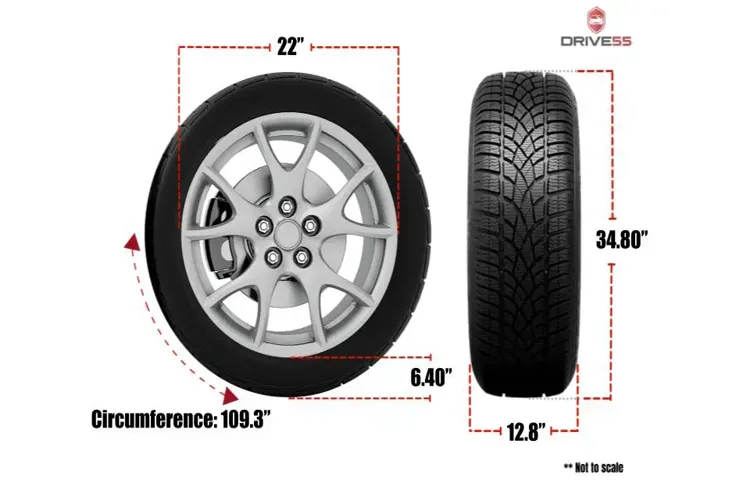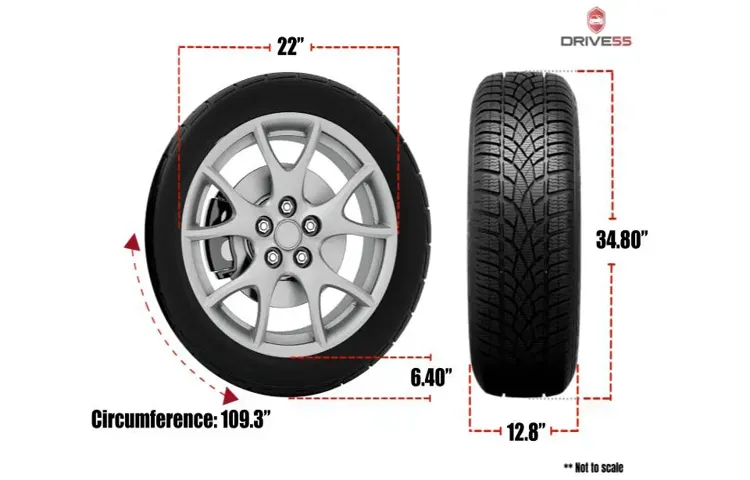When it comes to changing tires, one of the essential factors you need to consider is the tire size. Different vehicles require different tire sizes, and understanding the significance of these numbers is crucial to ensure that you choose the right fit for your car. This is where the tire size 325 comes in.
So what exactly does the number 325 mean? Simply put, it refers to the tire’s section width, which is the measurement of the contact between the road and the tire, given in millimeters. This means that a tire size of 325 indicates that the tire’s width is 325 millimeters. But that’s not all there is to it.
The tire size also includes the aspect ratio, which is the ratio of the tire’s height to its width. For example, a tire with a size of 325/30 means that the tire’s height is thirty percent of its width. Additionally, the tire size also includes the rim diameter, which is the diameter of the wheel that the tire fits onto, given in inches.
A tire with a size of 325/30/21 would, therefore, have a width of 325mm, a height of 30 percent, and fit on a 21-inch rim. Understanding the tire size is vital to ensure that you choose the right tire for your vehicle, as using the wrong size can affect your car’s performance and safety. Moreover, the tire size also affects the tire’s speed, load capacity, and overall performance.
Therefore, when considering changing tires, make sure you do your research and get the right tire size for your vehicle.
Table of Contents
Understanding Tire Sizing
If you’re wondering, “What size tire is a 325?”, it’s important to know that tire sizing can be a bit confusing. The 325 in the question refers to the width of the tire in millimeters. In general, tire sizing consists of a series of numbers and letters that indicate the tire’s width, aspect ratio, and diameter.
For example, a tire with a size of P235/60R18 means it is a passenger tire with a width of 235 millimeters, an aspect ratio of 60%, and a diameter of 18 inches. It’s important to note that different types of vehicles require different tire sizes, so be sure to check your vehicle’s owner’s manual or ask a professional for guidance. Understanding tire sizing can help you choose the right tires for your vehicle and ensure optimal performance and safety on the road.
Tire Width
When it comes to tire sizing, one of the most important factors to consider is the width of the tire. This measurement is typically listed in millimeters and can be found on the sidewall of the tire. The width of a tire can vary depending on the make and model of the vehicle, as well as the intended use of the tire.
A wider tire can offer better traction and handling, especially on dry roads, but may also create more drag and decrease fuel efficiency. On the other hand, a narrower tire can make for a smoother ride and better fuel economy, but may not perform as well in certain driving conditions. Ultimately, the best tire width for your vehicle will depend on your individual needs and preferences.
So, be sure to do your research and talk to a professional before settling on a particular tire size and width.

Aspect Ratio
Understanding tire sizing can be a confusing task, especially when it comes to the aspect ratio. The aspect ratio is the height of the tire sidewall as a percentage of the width. For example, if a tire’s width is 225mm and its aspect ratio is 50, the height of the sidewall is 50% of 225mm.
This means the tire’s sidewall height would be 115mm. The aspect ratio plays a significant role in how a tire handles on the road.
Tires with a higher aspect ratio typically have a more comfortable ride and better traction in wet conditions. On the other hand, tires with a lower aspect ratio tend to provide better handling and steering response due to their stiffer sidewalls. When choosing tires, it’s essential to consider your driving needs and find the aspect ratio that fits your driving style.
By understanding the aspect ratio, you can make an informed decision when selecting the right tire for your vehicle.
Rim Size
Tire sizing can be quite a confusing and intimidating process, but with a bit of understanding, it doesn’t have to be. One crucial aspect of tire sizing is rim size, which is typically measured in inches. This measurement refers to the diameter of the wheel that the tire is designed to fit on.
It’s vital to select the correct rim size for your vehicle, as a mismatch can lead to a range of problems, such as poor handling and incorrect speedometer readings. Rim size should be chosen based on your vehicle manufacturer’s specifications, as different brands and models have varying requirements. While selecting a larger rim size may look visually impressive, it can put added stress on your suspension and lead to a rougher ride.
In contrast, selecting a smaller rim size can affect your vehicle’s braking performance and stability. So, it’s essential to understand the correct rim size for your vehicle and avoid taking risks with oversizing or undersizing.
What Size Tire is a 325?
If you’re wondering what size tire is a 325, the answer depends on a few factors. A 325 tire size typically refers to the width of the tire in millimeters. So a 325 tire would be 325 millimeters wide.
However, tire sizes also include a series of numbers that provide additional information about the tire’s dimensions, such as the aspect ratio and diameter. For example, a common 325 tire size is 325/30R1 In this case, the aspect ratio is 30, meaning the height of the tire is 30% of its width.
The R denotes that it is a radial tire, and the 19 represents the diameter of the rim in inches. It’s important to note that not all tires with a 325 width will have the same series of numbers, so it’s essential to check the tire size specifications when purchasing a new tire.
Comparable Tire Sizes
If you’re wondering about the comparable tire sizes for a 325, there are a few options you could consider. The 325 tire size is typically found on high-performance cars and is equivalent to a 205/50R17 or a 245/40R1 These are both similar sizes and offer comparable performance to the 325, but it’s always important to check your vehicle owner’s manual for the specific tire size recommended for your car.
Remember, using the correct tire size is vital for optimal performance and safety, so don’t overlook this important step when shopping for new tires. Overall, whether you choose a 325 or a comparable size, it’s important to invest in quality tires that suit your driving needs and provide long-lasting durability.
Metric Sizes
When it comes to selecting new tires for your vehicle, deciphering the various sizes and measurements can be confusing. One size format that you may come across is metric sizes, which are typically denoted with a “P” before the measurement. While this format may seem unfamiliar to some, there are comparable tire sizes within the more commonly used inch measurement system.
For example, if your vehicle requires P235/60R16 tires, this would be equivalent to a 235/60R16 or 27x25R16 tire. It’s important to note that while comparable, these sizes may have slight variations in their specifications, such as load carrying capacity or speed rating.
Therefore, it’s crucial to consult with a tire professional or your vehicle’s owner manual to ensure you choose the correct tire size and type for your specific needs.
Inches Sizes
When it comes to buying new tires, there are a lot of things to consider – including the size. One common format for tire size is in inches, which can be confusing if you’re used to metric measurements. If you’re unsure what size of tire you need, there are comparable sizes that can help you find the right fit.
For example, a 215/45R17 tire is similar in size to a P225/50R16 tire. It’s important to keep in mind that the size of your tire can impact your car’s performance and safety. Always consult with a professional or consult your owner’s manual to ensure you select the correct size for your vehicle.
Conclusion
In conclusion, asking what size tire is a 325 is akin to asking how long is a piece of string. While it may seem like a straightforward question, the answer ultimately depends on various factors, such as the specific type of tire, the aspect ratio, and the rim’s diameter. So, the next time someone asks you what size tire is a 325, remember that the answer is not as black and white as you may think.
It’s all about the details, my friend.”
FAQs
What does the number 325 refer to in tire size?
The number 325 in tire size refers to the width of the tire in millimeters.
Can I use a tire size other than 325 on my vehicle?
It depends on your vehicle and the recommended tire size. Check your owner’s manual or consult with a tire professional to determine the appropriate tire size for your vehicle.
What is the difference between a 325/60R20 tire and a 325/65R20 tire?
The first number in the tire size (325) refers to the width in millimeters, while the second number (60 or 65) refers to the aspect ratio or the percentage of the tire’s height to its width. The difference between a 60 and 65 aspect ratio is a slightly taller tire with a 65 aspect ratio.
Are 325 size tires suitable for off-road driving?
325 size tires can be suitable for off-road driving depending on their tread pattern and design. There are specific tires designed for off-road use that may be better suited for that purpose.
Can I mix tire sizes on my vehicle?
It is not recommended to mix tire sizes on a vehicle. All tires on a vehicle should be the same size and type to ensure optimal performance and safety.
How do tire sizes affect my vehicle’s performance?
Tire sizes can affect multiple aspects of a vehicle’s performance, including handling, acceleration, and fuel efficiency. The recommended tire size for a specific vehicle is chosen to provide the best overall performance.
What is the recommended tire pressure for a 325 size tire?
The recommended tire pressure for a 325 size tire can vary depending on the vehicle and tire manufacturer. Check your owner’s manual or consult with a tire professional for the recommended tire pressure for your specific tire and vehicle.



